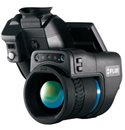Often used for inspection of electrical panels, piping and other infrastructure,
thermal imaging cameras may seem like they have a pretty clear-cut line of duties. However, these heat-seeking devices have experienced somewhat of a renaissance in recent years, and are becoming increasingly useful, even cropping up in specialized smartphone cases to give ordinary people a chance to play heat detective. Engineers aren't the only ones who use infrared technology anymore – here are five unexpected ways you can put a thermal imaging camera to use.
1. Isolate Water Damage
The northeastern part of the United States has experienced a couple rough winters, with more snow than anticipated. The increased snowfall resulted in some water damage to homes, which can ruin insulation and cause heat to escape the dwelling. General Contractor Chris Rapczynski reported that Bostonian’s saw a roughly 36% increase to their energy bills, so he found a creative way to seek out water damage in a home, without having to bust through the wall and cause further destruction. He used a thermal imaging camera to isolate water damage (which would appear as hotspots, where heat was leaking out). It saved his clients time and money, and got right to the root of the problem.
2. Estimate Clothing Insulation

Not too long ago, a prominent clothing manufacturer contacted ATEC and asked about renting a thermal imaging camera. They were looking to determine heat loss of one of their winter coats compared to similar products from competitors. They decided to rent the
Flir T1020, a high-performance thermal imaging camera with exceptional accuracy and image resolution. With it, this clothing manufacturer was able to compile data regarding the heat loss of their coats and compare with competitors, finding that their coats were in fact better at retaining heat than others. They were able to use these findings in ad campaigns and promotional brochures, and apply it to their own internal research.
3. Search and Rescue
In the aftermath of tornadoes, earthquakes, hurricanes, and other phenomena that cause damage to structures, finding missing persons a daunting, incredibly time sensitive task. When walking through a damaged building where people may be trapped, thermal cameras can pick up the body heat of the missing person who may be injured and unconscious, and therefor unable to call for help. It could also be difficult for a search and rescue team to see through darkness or smoke within the room, so the use of thermal imaging technology helps rescue teams pinpoint the missing person.
4. Stop Health Pandemics
.jpg)
During periods of widespread disease, thermal imaging cameras have been used to help stop the spread of infection. These cameras can help identify passengers with a fever while they pass through an airport checkpoint, helping to stop the spread of the illness to a new region. During the deadly Ebola virus outbreak in 2014, thermal imaging cameras were used in international airports to check for fever (the first sign of illness) in passengers traveling from regions that were suffering the pandemic. It’s not a perfect system – fevers can be the result of multiple causes, and in the case of Ebola, the initial fever might not show up for up to three weeks after becoming infected – but it does help wean out who may need to hold back for further medical attention.
5. Help the DEA
Law Enforcement drug units have been able to identify homes that are producing drugs with the use of thermal imaging cameras. When a house or building has abnormally high temperatures, it can be indicative of grow lamps or laboratory set ups used to cook illegal substances. A thermal imaging camera can help provide the final piece of evidence needed to obtain a warrant and move forward with a bust.
To learn more about ATEC’s extensive inventory of
thermal cameras or request a quote, please feel free to contact us directly at 800-404-2832.